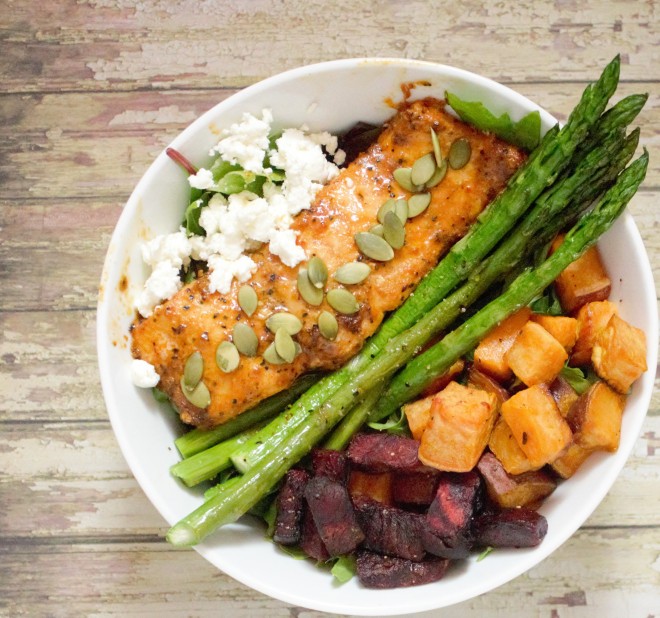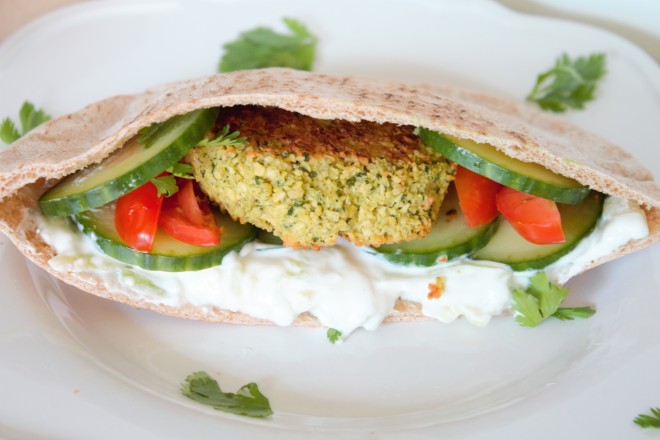As a dietitian, I strongly believe that what we eat plays a huge role in our fertility. I mean, food affects everything when it comes to our health, reproductive health included. There are so many physiological functions that have to run smoothly in order for conception to occur. Giving your body the nutrients it thrives on might not only help you conceive, but could also help you enjoy a healthy pregnancy and a healthy baby to boot!
There are countless stages that couples find themselves in when starting or growing their family. You might be wanting to start trying to conceive in the next couple of months. Maybe you’ve already been trying for a few months. Maybe you’ve been diagnosed with infertility, because you’ve been trying for over a year. Maybe getting pregnant isn’t even on your radar! If you’re not actively trying to get pregnant, but you’re considering it as an option within the next few years, it never hurts to start making healthy lifestyle changes now.
I’ve counseled countless people on the many benefits of living a healthier lifestyle, but no patient population is more engaged and dedicated than those women, and their partners, trying to get pregnant. At some point during the baby-making journey, especially if it’s taking longer than expected, an assessment of diet and lifestyle choices is imminent.
While an overall healthy diet itself can boost fertility, there are some specific recommendations that those aiming to get knocked up should focus on. These recommendations come from the research led by Drs. Jorge Chavarro and Walter Willett of the Harvard School of Public Health, which was ultimately published in a book, The Fertility Diet. Previous to their findings in 2007, research on the topic of nutrition and fertility was scarce. They used information from the Nurses Health Study, which looked at tens of thousands of women through their reproductive years, many of whom were trying to get pregnant. They were able to identify risk factors for infertility, specifically relating to anovulatory infertility, (when an egg is not released from the ovary as expected). Here are some of the specifics they discuss:
-
Switch all grains to whole.
Whole grains provide enormous nutritional benefits, such as fiber, protein, and vitamins that you won’t get in refined grains. The fiber itself helps to fill you up faster and for longer, a huge bonus if you’re one of those people that’s “always hungry” or never really feels satiated. By switching to whole grains, you are now omitting many simple carbohydrates from your diet. Why does this matter? Simple carbs cause blood sugar spikes -> blood sugar spikes can lead to insulin resistance -> insulin resistance is not good for fertility. Think of insulin resistance as your body not being able to regulate your blood sugar properly. A fluctuating blood sugar means that your energy level and mood will fluctuate as well. If you suffer from chronic “blah” feeling (yes, that’s a medical term I just made up), low energy, have been diagnosed with Polycystic Ovarian Syndrome (PCOS), or have stubborn fat around your abdomen that you can’t seem to lose, you could benefit tremendously from switching to whole grains.
- How to get started: Mix it up, literally! The next time you make white rice, make wild or brown rice as well and combine the two. Do the same with pasta, mix white pasta with whole grain varieties. Check cooking times on the box, as you might start one before the other. This could be a realistic way to ease into the transition to whole grains… and bonus, your family might not even notice!

A bowl of brown rice (simmered in broth) topped with steamed peas, roasted tomatoes & sweet potato, and a scoop of cilantro cashew butter.
2. Swap unhealthy fats for healthy ones.
Notice that I used the word swap. Don’t just start downing avocado and guzzling olive oil without eliminating fertility-killing fats, called trans fats. Trans fats are found in items such as fried fast food, powdered coffee creamer, donuts, some margarines, and “movie theater butter” popcorn. You’ll know if trans fast are in a product if the ingredients list contains “partially hydrogenated oil.” Limit foods high in saturated fats too, as excessive intake of these contribute to insulin resistance as well. These foods include processed meats like bacon and sausage, fried foods, butter, shortening, and coconut oil. As you work on limiting unhealthy fat sources from your diet, focus on increasing foods like avocado, nuts, seeds, and seafood like salmon and tuna.
- How to get started:
- Instead of -> ribeye steak choose -> salmon filet
- Instead of -> chips choose -> nuts
- Instead of -> butter, bacon grease, or coconut oil choose -> extra virgin olive oil, avocado oil, or canola oil
- Instead of -> salami, bologna, or spam choose -> sliced turkey breast or lean ham
- Instead of -> deep fried choose -> baked or grilled

Wild Alaskan salmon topped with goat cheese & pumpkin seeds + roasted asparagus, beets, and sweet potato (drizzled with EVOO and freshly cracked black pepper) over a bed of mixed greens.
3. Add one serving of whole-milk dairy daily.
This one seems contradictory since I just talked about limiting saturated fat, but according to the Nurses Health Study, it could decrease your risk of anovulatory infertility. The underlying mechanism is unclear, but you can’t deny the findings– in the study mentioned above, there was an inverse association between dairy fat intake and anovulatory infertility.
- How to get started: Next time you’re tempted to reach for that fat-free yogurt for your mid-morning snack, instead choose the whole milk version and enjoy every scrumptious spoonful!

Whole milk plain Greek yogurt topped with berries, pumpkin seeds, chocolate chips, chia seeds & ground flaxseed. Oh hey, I’m in the spoon!
4. Eliminate processed meat intake, limit red meat intake, and increase plant protein intake.
The bottom line here is to try to replace some of the animal protein in your diet with plant-based protein. Intake of vegetable rather than animal-based protein was a dietary factor prospectively reviewed and related to lower risk of ovulatory disorder infertility. Processed meats like sausage, bacon, salami, and hot dogs contain loads of sodium, saturated fat, nitrates, and nitrites, which are all known fertility-killers. Excessive red meat intake can cause you to take in excessive amounts of saturated fat, potentially leading to inflammation and weight gain. Healthier protein choices than the aforementioned options include lean poultry, seafood, beans, peas, lentils, eggs, nuts, seeds, dairy, and nut butters.
- How to get started: The next time you plan to use ground beef in a recipe, use half the amount you normally use and combine it with ground turkey breast or diced mushrooms.

A sprouted whole wheat pita half stuffed with baked falafel, cucumbers, tomato, and creamy tzatziki sauce.
5. Eat more vegetables.
Do you eat enough vegetables? If you hesitated before the answer to that question popped into your mind, you could probably benefit from eating more. While all vegetables are nutritious, those higher in iron and folic acid, including spinach, kale, and asparagus should be included into your daily diet. Although iron and folic acid may not necessarily increase your fertility, these nutrients are essential for a developing fetus, especially during those early weeks before some even know they’re pregnant. Vegetables promote health due to their high fiber content, high vitamin and mineral content, and their antioxidant benefits. It’s also a good rule of thumb to take a prenatal vitamin if you’re trying to get pregnant, but remember that a supplement does not replace a healthy diet.
- How to get started: Add a salad to your lunch and dinner meals. If you often find yourself buying salad ingredients but they go bad before you use them, try this. Find the biggest bowl you have and make one huge salad. Keep it covered in the fridge.* You can scoop from this bowl over the course of a few days (depending on how much you make) until it’s gone. You’ve made it once but you benefit from it over and over. *Put a paper towel in the bowl with the salad to absorb any moisture that might accumulate. This keeps the veggies fresh for longer.

A salad of mixed greens, Brussels sprouts, carrots, tomato, onion, sunflower seeds, and garbanzo beans. Salads don’t have to be boring!
6. Exercise & maintain a healthy weight.
The physical and mental benefits that exercise provides makes it an essential ingredient in the recipe for getting pregnant. Not only does exercise reduce stress, improve blood flow, and regulate blood sugar, but it also aids in weight loss. For both women and men, obesity is associated with infertility. Maintaining a healthy weight is easier when exercise becomes a part of your lifestyle. Interestingly enough, exercise, regardless of your current weight, has fertility-boosting benefits in itself, according to the National Infertility Association.
- How to get started: You know yourself. Set realistic goals for how often and how long you will exercise. Start with going on a daily walk and eventually make that walk longer and faster. If you don’t have a ton of motivation to work out on your own, consider joining a gym with group fitness classes. Enlist a workout buddy. Hire a personal trainer. It’s worth the money if you actually use it! Your body, and future baby, will thank you.




